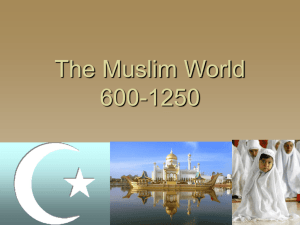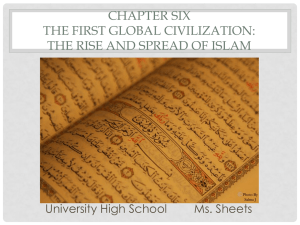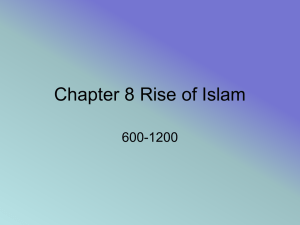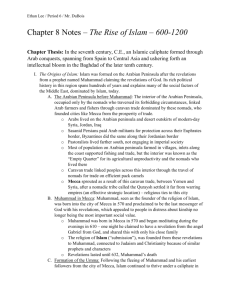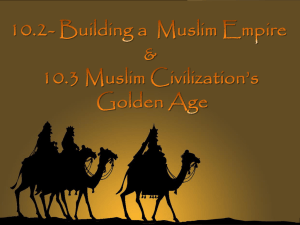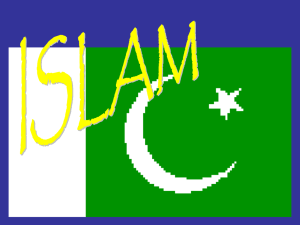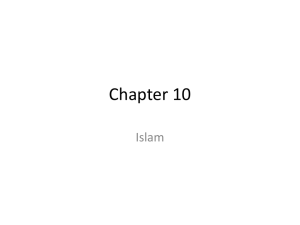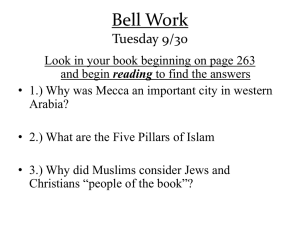The Expansive Realm of Islam
advertisement
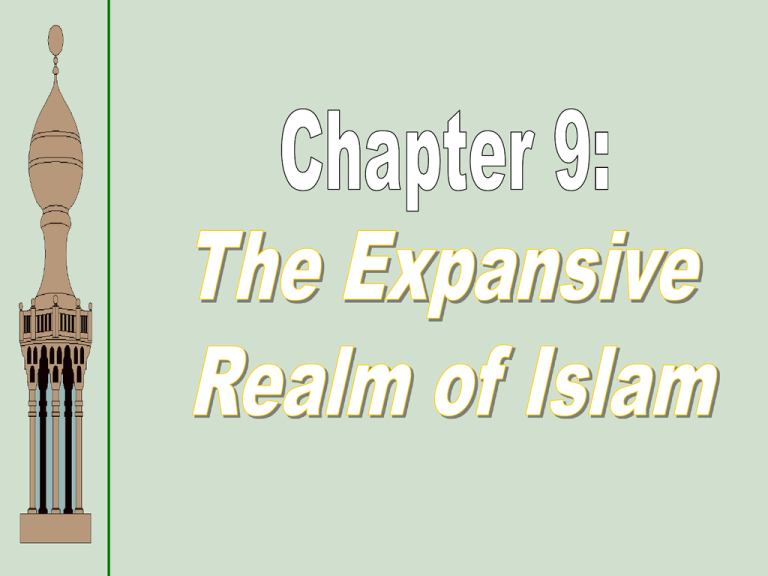
Muhammad and His Message • Born 570 to merchant family in Mecca • Orphaned as a child • Marries wealthy widow c. 595, works as merchant • Familiarity with paganism, Christianity and Judaism as practiced in Arabian peninsula Muhammad’s Spiritual Transformation • • • • Visions c. 610 CE Archangel Gabriel Monotheism – Allah Attracts followers to Mecca IslamAn Abrahamic Religion Muslims are strict monotheists. They believe in the JudeoChristian God, which they call Allah. Muslims believe that the Torah and the Bible, like the Qur’an, is the word of God. Peoples of the Book Abraham’s Genealogy HAGAR ABRAHAM Ishmael SARAH Isaac 12 Arabian Tribes Jacob Esau 12 Tribes of Israel The Prophetic Tradition (25 In All) Adam Noah Abraham Moses Jesus Muhammad The Quran • Record of revelations received during visions • Committed to writing c. 650 CE (Muhammad dies 632) • Tradition of Muhammad’s life: hadith The Qur’an Muslims believe it contains the word of God. 114 suras (chapters). In the name of Allah, the compassionate, the merciful. Written in Arabic. Conflict at Mecca • Muhammad’s monotheistic teachings offensive to polytheistic pagans • Economic threat to existing religious industry • Denunciation of greed affront to local aristocracy The Hijra • Muhammad flees to Yathrib (Medina) 622 CE – Year 0 in Muslim calendar • Organizes followers into communal society (the umma) • Legal, spiritual code • Commerce, raids on Meccan caravans for sake of umma Muhammad’s Return to Mecca • Attack on Mecca, 630 • Conversion of Mecca to Islam • Destruction of pagan sites, replaced with mosques – Ka’aba preserved in honor of importance of Mecca – Approved as pilgrimage site – Covered in kiswah (“robe”) annually The Ka’aba 1. The Shahada The testimony. The declaration of faith: There is no god worthy of worship except God, and Muhammad is His Messenger [or Prophet]. 1 2. The Salat The mandatory prayers performed 5 times a day: * dawn * noon * late afternoon * sunset * before going to bed Wash before praying. Face Mecca and use a prayer rug. 2 2. The Salat The call to prayer by the muezzin in the minaret. Pray in the mosque on Friday. 2 3. The Zakat Alms giving (charitable donations). Muslims believe that all things belong to God. Zakat means both “purification” About 2.5% of your income. and “growth.” 3 4. The Sawm Fasting during the holy month of Ramadan. Considered a method of selfpurification. No eating or drinking from sunrise to sunset during Ramadan. 4 5. The Hajj The pilgrimage to Mecca. Must be done at least once in a Muslim’s lifetime. 2-3 million Muslims make the pilgrimage every year. 5 5. The Hajj Those who complete the pilgrimage can add the title hajji to their name. 5 Jihad • “struggle” – Against vice – Against ignorance of Islam • “holy war” – Against unbelievers who threaten Islam The Dome of the Rock Mosque in Jerusalem Mount Moriah Rock where Muhammad ascended into heaven. Islamic Law: The Sharia • Codification of Islamic law • Based on Quran • Extends beyond ritual law to all areas of human activity Other Islamic Religious Practices Up to four wives allowed at once. No alcohol or pork. No gambling. Three holiest cities in Islam: * Mecca, Medina, Jerusalem. The Caliph • No clear to successor to Muhammad identified • Abu Bakr chosen to lead as Caliph • Led war against villagers who abandoned Islam after death of Muhammad The Spread of Islam Easy to learn and practice. No priesthood. Teaches equality. Non-Muslims, who were “Peoples of the Book,” were allowed religious freedom, but paid additional taxes. Easily “portable” nomads & trade routes. Jihad (“Holy War”) against pagans and other non-believers (“infidels”). The Spread of Islam • Great warriors with a strong cavalry. • Byzantines and Persians weak from fighting each other. • Unity in Islam, strengthened by the Sharia, coupled with fair treatment of conquered people, was inviting to many in defeated empires who desired more freedom and cohesiveness. • Difficulties governing rapidly expanding territory The Expansion of Islam, 632 – 733 CE Muslims in the World Today Countries with the Largest Muslim Population 1. Indonesia 183,000,000 6. Iran 62,000,000 2. Pakistan 134,000,000 7. Egypt 59,000,000 3. India 121,000,000 8. Nigeria 53,000,000 4. Bangladesh 114,000,000 9. Algeria 31,000,000 10. Morocco 29,000,000 5. Turkey 66,000,000 * Arabs make up only 20% of the total Muslim population of the world. Successors To The Prophet • After the death of Muhammad, the caliph, or successor to the prophet was chosen. Abu Bakr was nominated as the first caliph. • Abu Bakr would lead the first caliphate, known as the Rashidun or Patriarchal Caliphate. • The choice of Abu Bakr caused significant dispute as many believed that Muhammad had chosen Alī ibn Abī Tālib, the cousin and son-in-law of Muhammad to succeed him. • Served as caliph 656-661 CE, then assassinated along with most of his followers Successors To The Prophet • Abu Bakr was followed by three more caliphs, the last of which was Alī ibn Abī Tālib. It is with his succession that a division in Islam became more defined. • Sunni Muslims believe that Ali was the fourth caliph, a position chosen based on ability to lead. The Shi’a (Shiites) believe that Ali is the first Imam, and that only blood descendants of Muhammad can lead the Muslim people. Major Muslim Empires • Rashidun Caliphate (622-661) • Umayyad Caliphate (661-750) • • • • – Umayyad Caliphate of Cordoba in Islamic Spain (929-1031) Abbasid Caliphate (750-1258) Fatimid Caliphate (910-1171) Mamluk Caliphate (1250-1517) The Ottoman Caliphate (15171924) Shi’ite Pilgrims at Karbala The Umayyad Dynasty (661-750 CE) • From Meccan merchant class • Brought stability to the Islamic community • Capital: Damascus, Syria • Associated with Arab military aristocracy Policy toward Conquered Peoples • Favoritism of Arab military rulers causes discontent • Limited social mobility for non-Arab Muslims • Head tax (jizya) on non-Muslims • Umayyad luxurious living causes further decline in moral authority The Abbasid Dynasty (750-1258 CE) • Abu al-Abbas Sunni Arab, allied with Shia, non-Arab Muslims • Seizes control of Persia and Mesopotamia • Defeats Umayyad army in 750 – Invited Umayyads to banquet, then massacred them Nature of the Abbasid Dynasty • Diverse nature of administration (i.e. not exclusively Arab) • Militarily competent, but not bent on imperial expansion • Content to administer the empire inherited • Dar al-Islam • Growth through military activity of autonomous Islamic forces Abbasid Administration • • • • Persian influence Court at Baghdad Influence of Islamic scholars Ulama and qadis sought to develop policy based on the Quran and sharia Caliph Harun al-Rashid (786-809 CE) • High point of Abbasid dynasty • Baghdad center of commerce • Great cultural activity Abbasid Decline • Civil war between sons of Harun alRashid • Provincial governors assert regional independence • Dissenting sects, heretical movements • Abbasid caliphs become puppets of Persian nobility • Later, Saljuq Turks influence, Sultan real power behind the throne Economy of the Early Islamic World • Spread of food and industrial crops – Trade routes from India to Spain • Western diet adapts to wide variety • New crops adapted to different growing seasons – Agricultural sciences develop – Cotton, paper industries develop • Major cities emerge Formation of a Hemispheric Trading Zone • Historical precedent of Arabic trade • Dar al-Islam encompasses silk routes – ice exported from Syria to Egypt in summer, 10th century • Camel caravans • Maritime trade Banking and Trade • Scale of trade causes banks to develop – Sakk (“check”) • Uniformity of Islamic law throughout dar al-Islam promotes trade • Joint ventures common Al-Andalus (Islamic Spain) • Muslim Berber conquerors from North Africa take Spain, early 8th c. • Allied to Umayyads, refused to recognize Abbasid dynasty – Formed own caliphate – Tensions, but interrelationship Changing Status of Women • Quran improves status of women – Outlawed female infanticide – Brides, not husbands, claim dowries • Yet male dominance preserved – Patrilineal descent – Polygamy permitted, Polyandry forbidden – Veil adopted from ancient Mesopotamian practice Formation of an Islamic Cultural Tradition • Islamic values – Uniformity of Islamic law in dar al-Islam – Establishment of madrasas – Importance of the Hajj • Sufi missionaries – Asceticism, mysticism – Some tension with orthodox Islamic theologians – Wide popularity Al-Ghazali (1058-1111) • Major Sufi thinker from Persia • Impossibility of intellectual apprehension of Allah, devotion, mystical ecstasy instead Cultural influences on Islam • Persia – Administration and governance – literature • India – Mathematics, science, medicine • “Hindi” numbers • Greece – Philosophy, esp. Aristotle – Ibn Rushd/Averroes (1126-1198) Muslims in America Muslim Culture in NYC The Islamic Center, New York City Islam’s Golden Age • Islam’s golden age peaked under the Abbasids, during which Muslims absorbed the customs and traditions of the many diverse people they ruled. • The emphasis on learning, which was taught by Muhammad, was reinforced by a flourishing economy based on trade. Art & Architecture • Mosques & Palaces – Byzantine domes and arches – Abstract & geometric patterns • Calligraphy – Often verses from the Quran • Drawings & Paintings Literature & Philosophy • Poetry – Much based upon themes of the Quran • Preservation of Greco-Roman scholars • Tales – Most famous is The Thousand and One Nights • Philosophy Mathematics & Science • Algebra – Based upon Indian & Greek advancements, the Muslims pioneered algebra • Astronomy – Observed the Earth’s rotation – Calculated the circumference of the earth within a few thousand feet • Medicine – Doctors had to pass rigorous tests – Hospitals set up – Studied diseases and wrote medical encyclopedias that became standard texts in Europe Economics • Agriculture • Trade – Cultural diffusion – Partnerships, credit, banks • Manufacturing – Guilds regulated prices, weights & measurements – Specialized in steel, leather & carpets

